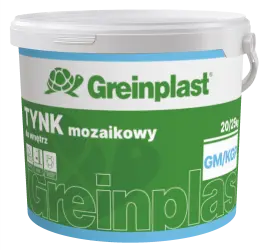

Used in manual coverage of external facade elements, as well to cover parts of internal walls that are especially exposed to frequent use, such as corridors, staircases etc. (plaster with 0.5-1.2 mm granulation can only be applied inside buildings). Can be applied on all typical mineral bases, such as: concrete, cement, cement-lime, lime-cement, lime, gypsum plasters etc. after a minimum of 28 days after they are placed, and as plastering on layers with mesh reinforcement in Greinplast insulation systems, minimum 3 days after they are laid. It is an integral element of product ranges in Greinplast G insulation systems (according to AT) and Greinplast EPS (according to ETA). The material available in colours that can be found in the manufacturer's colour scheme. Upon the customer's request, other colour schemes are available.
Packaged in 30, 15 and 5kg containers.
Only after suitable preparation of the base and when it has completely dried off, the actual plastering works may be commenced. In order to achieve the correct working consistence, it is allowed to add a small amount of water; maximum 1% per package. The mass needs to be well agitated directly before its application. Stainless steel trowel should be used to apply and smoothen the plaster. In order to obtain a homogenous plaster structure, apply the mass at a grain thickness over the entire worked surface, using material from a single production batch. Too strong smoothening may lead to the formation of uneven spots.
Show moreThe ambient temperature during the plaster application and drying should be between +5°C and +30°C. The optimal application temperature is +20°C. During the plaster application, until it is completely dry (minimum 3 days from the work completion); it is strictly recommended that care should be taken to secure the plaster against adverse weather conditions. During this period, temperatures below 5°C are not allowed. The plaster drying time may vary greatly, especially during periods with adverse weather conditions. Failure to observe the aforementioned recommendations, bad base preparation or incorrect plaster application may lead to the appearance of permanent colour differences on plastering surfaces (efflorescences, dye penetration), and in extreme scenarios – reduction of its durability and even flaking. Immediately after the application, the plaster is milky-white; this colour will fade away as hardening will progress. High air humidity substantially increases plaster drying time and may cause the formation of a lighter, vanishing tarnish. When using in enclosed areas, these should be aired until the characteristic smell disappears.
Information contained in the manual help ensure the optimal use of the product, however, it does not create any legal liability of the Manufacturer, due to the fact that the conditions of use remain outside of its control. We do not accept any responsibility if the material is combined with products from other Manufacturers or with such that are not listed in the reference documents (AT & ETA).